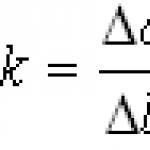You can decorate a painting, photograph, embroidery, etc. in various ways. One of them is a passe-partout or print. At its core, it is cardboard (but you can also use thick paper), made in a special way. Making a mat for a painting with your own hands is very simple; in this article we will tell you about the three most popular methods. There will be videos too.
Passepartout for a DIY painting
Before you begin making this decorative element, it is important to note some of the subtleties of its choice. First of all, why do you need such a design?
It is beautiful and original, plus everything helps to emphasize your work (painting or embroidery);
You can add inscriptions;
There is no need to select a frame exactly according to the size of the work.
How to choose a passe-partout?
As in any other creative work, harmony and a sense of proportion are important here. When choosing this design you need:
- maintain the color scheme, so the mat should contrast with the picture;
- maintain a certain aspect ratio (the width may vary, you need to find the option that suits you, often the width of the mat is twice the width of the picture frame).

Manufacturing method No. 1 (with edging)
To make a passe-partout for a photo or painting with your own hands, we will need:
-
stationery knife;
ruler and corner;
a simple pencil;
cardboard, however, you can also take a sheet of Whatman paper;
thick colored paper or wallpaper (yes, this option is also possible);
To make a passe-partout yourself you need to have a little patience - it’s not a lot of work, but it’s neat. We have broken down the manufacturing method into simple steps:
1. We measure the finished work for which we are making a passe-partout. Then we take a sheet of whatman paper or cardboard, it should be twice the size of our photo / painting / drawing, we outline a rectangle that matches the size of the finished work (you can simply circle the picture).
It is important that the distance from the edges of the cardboard to the border of the work is the same.
2. Now cut out our outlined rectangle. The result will be a sheet of Whatman paper with a window in the middle.
Then you need to make an edging from colored paper or wallpaper. To do this, you need to cut 4 strips 4 cm wide (2 strips are equal in length to the width of our picture, and 2 to its length).
Then we bend the cut strips in half lengthwise. In the middle we leave a narrow edging 2 millimeters wide.
4. Then you need to glue the edging to the cardboard.
Important! Apply glue to cardboard or Whatman paper, as colored paper has a lower density and may deteriorate. And pay attention to the joints in the corners.
5. After the glue has dried, attach a photo or drawing on the back side, adjust it the way you like, fix it and can insert it into a frame.

If you are decorating embroidery in a passe-partout, then you must first fix it on a sheet of thick cardboard. You can use a regular office stapler for these purposes.
Manufacturing method No. 2 (popular)
To make a passe-partout using this method you will need:
picture frame;
a sheet of cardboard, whatman paper, wallpaper or watercolor paper;
scissors and stationery knife;
The article is almost on topic: How to make a bookmark for a book with your own hands - a huge number of ideas and options.
1. Each photo (picture) frame is accompanied by a piece of cardboard, the one that fixes the image on the back. And if it fits tightly, then we will take it as the basis for our passe-partout. To do this, take a piece of cardboard, place it on a sheet of Whatman paper or watercolor paper, trace and cut out a rectangle of the desired size.

3. Then, in accordance with the calculations, we draw a frame - a passe-partout cutout. Then we retreat 2 mm inward from it and draw another frame.
4. Next we need to measure the smallest width of the mat (we take measurements from the edge of the Whatman paper). And from the first frame (the one closest to the edge), draw another one, the width coinciding with the smallest width of the print (in the example in the video, a little smaller is taken, this is acceptable). Immediately draw the lines of future cuts in the corners.
5. Now we need to make the depth of the print. To do this, take a spoon or fork, and with its back side, using a ruler, press the passe-partout along a narrow edge (these are the 2 mm that we outlined between the first and last frames).
6. Then cut out the inside of a sheet of whatman paper (watercolor paper). You can use scissors, you can use a stationery knife or a scalpel, whichever is more convenient for you.
7. Then you need to make corner cuts. Attention! They should be done up to the frame, which is closer to the edge.
8. We bend the resulting “petals” inward along the ruler, along the line that is closer to the center.
9. Using glue, at one point, we fix our photo / drawing from the inside on the mat. It's better to use PVA - it doesn't leave marks. And put it in a frame under glass.
Step by step video
Everything is described and clearly shown in the video.
Manufacturing method No. 3 (simplest)
To make a passe-partout with your own hands using this method, you need to prepare:
cardboard, whatman paper, wallpaper, in other words, whatever you like best and suits the drawing;
scissors, stationery knife;
We decide on the size of the print. Usually on each side it is 5-7 cm larger than the finished photo.
The rest of the steps are in a short video. You will be surprised how simple this method is.
Fabric prints look very original and cozy.
If you take wallpaper instead of ordinary Whatman paper, then such a picture will be in harmony with the wall.
Framing workshop services are not cheap. But you can create a decent design for your embroidery yourself. In this article we will look at several ways to decorate embroidery with your own hands, and do it professionally and accurately.
Let's start with the very basics - how to properly insert embroidery into a frame.
How to carefully stretch embroidery onto a stretcher
First you need to determine the center of the embroidery and the backing. Draw central vertical and horizontal lines on the stretcher. Similarly, define these lines on the embroidery. Now align these two centers and secure with pins on the right side. This technology will allow you to avoid distortions of the canvas when stretching it onto the substrate.
Check if you are happy with how the embroidery is positioned and if there are any distortions. Only after this (aligning and securing the centers) cut off the excess canvas, leaving 3-4 cm around the entire perimeter. Process the edges of the canvas:

Starting from the center, moving to the outer corners, pull the canvas onto the stretcher and secure with pins, sticking them all the way to the end into the stretcher at a distance of about one centimeter. To avoid the appearance of folds and wrinkles on the canvas, when securing with a pin, choose the canvas thread as a guide and make sure that it is strictly perpendicular to you.
After securing the canvas around the entire perimeter of the stretcher, carefully tuck and sew the corner folds of the canvas:


Glue the edges of the canvas along the entire perimeter to the stretcher with double-sided adhesive tape.

This method of securing the canvas to the backing will allow you to avoid the appearance of distortions and folds in the embroidery, which often appear over time on unsecured canvas.
Passepartout for embroidery
Now let's look at two options for creating a textile mat for embroidery.
Option one:
Iron the embroidered canvas well from the wrong side:

Decide how wide your mat will be relative to the embroidery itself. On the wrong side of the canvas, mark its width:


Around the resulting outline of the passe-partout, draw another rectangle approximately 4 cm wide.

Trim the corners of the large rectangle. This is what you should get:

Make a copy of the wrong side of the canvas - this will be the pattern for the passe-partout:

Place tracing paper on the copy and copy the outline of the embroidery itself and the outer edge onto it:

Place the resulting pattern on the mat fabric:

Trim the fabric along the outer edge and cut along the outline of the embroidery inside:



Place the resulting passe-partout on the front side of the canvas:

Secure the fabric with pins:

Carefully sew the fabric and canvas along the contour around the embroidery:

This is what the backside looks like:
Place the subframe on the wrong side:


Fold the edges of the fabric over the stretcher and sew each corner of the bevel:

Secure the edges of the fabric to the stretcher using double-sided adhesive tape:

Insert into frame:


Yes, the process is long and quite labor-intensive, but it allows you to achieve maximum accuracy when preparing the work. And the result is without a doubt worth it.
Option two:
This method of making fabric mats is especially suitable for monochrome embroidery.
As a basis for the passe-partout, you can use thick cardboard, a frame made of chipboard or plastic.

Apply glue to the inside of the fabric and one side of the cardboard. Transfer the cardboard onto the fabric. Make sure to place it in the center of the piece of fabric, leaving equal parts on each side. Press the cardboard firmly onto the fabric. Check the front of the fabric to make sure all air bubbles are coming out:

Carefully trim the corners of the fabric, leaving a small allowance of a few millimeters at the corners of the cardboard:


Apply glue to the edges of the fabric and cardboard. Stretch the fabric over the cardboard, starting from an area near the corner. Iron the fabric firmly with your hand so that no air bubbles remain:

Cut the inside of the fabric diagonally in an X shape, starting at the corners. Cut out a rectangle, leaving 2-3 cm of fabric on each side:


We coat both surfaces with glue and stretch the fabric onto the cardboard, starting from the corners. It is worth paying attention to the outer corners - coat them with additional glue and smooth them with your finger:

Leave the finished mat to dry completely:

This method of creating a passe-partout involves a wide variety of color solutions; you just need to decide on the fabric pattern.
Video – “How to arrange embroidery in a passe-partout”
Video - “Independent design of embroidery in a frame with a passe-partout”
Hoop - like a frame for embroidery
 Using a hoop as a frame for embroidery is not a new idea, and has rather become a classic. And this is quite understandable, because the finished work thus acquires an original and very attractive appearance.
Using a hoop as a frame for embroidery is not a new idea, and has rather become a classic. And this is quite understandable, because the finished work thus acquires an original and very attractive appearance.
But using a hoop as a frame requires some subtleties.
In order for the embroidery to be well-designed, it is necessary to properly secure the canvas to the hoop. You cannot simply insert the embroidery into the hoop, tighten it tightly, and trim off the excess canvas around the edge of the hoop. And that's why:
- over time, the tension of the canvas in the hoop weakens, and if the edge is cut close to the hoop, then it will no longer be possible to tighten the embroidery;
- embroidery in a hoop, unlike an embroidered picture in a frame under glass, periodically requires washing; It’s unlikely that it will be possible to insert the embroidery back into the hoop with such an edge.
Let's look at several ways to secure embroidery in a hoop.
Option one:
This method involves fixing the canvas in the hoop “not tightly”; if necessary, the embroidery can be easily removed from the hoop at any time.

Trim the excess canvas around the hoop, leaving a strip slightly smaller than the radius of the hoop (for example, if the hoop diameter is 10cm, you should leave about 4cm):

Stepping back approximately 1cm from the edge of the canvas, sew in a circle using a “forward needle” seam. Do not tighten the knot too much:


This is what you should get:

Now grab both ends of the thread and pull the fabric evenly:

If you do everything carefully, the frills will meet in the center and will be flat (will not puff up):

Tie a knot at the end and you're done:

Option two:
This method no longer involves removing the embroidery from the hoop, but at the same time allows you to achieve maximum accuracy when decorating the embroidery.
Additionally, you will need a piece of cotton fabric that matches the size of the embroidery.

We place additional fabric on the inner hoop, put a canvas with embroidery on top, and secure everything on top with the outer hoop:

Carefully smooth out all the folds on both fabrics, align the embroidery, and finally tighten the hoop:

We cut the inner lining fabric flush with the inner hoop. Decide whether there is a need to cut the canvas itself - it should be wide enough to cover the width of the hoop:

Apply glue to the inner hoop of the hoop:

We press the canvas to the hoop along the entire perimeter:

This is what we end up with:


Hoop decor
If you use a hoop as a frame for embroidery, then like any other frame, they can also be decorated. And here it is the same, there are a lot of ideas, here are a few of them:
Decor with braid


In this case, the braid is simply glued from the wrong side along the edge of the hoop:

Decor with ribbons:


Fabric decor:
This method is not only original, but also practical - the fabric that is used to wrap the hoop protects the canvas from damage when the embroidery is pulled. In addition, the canvas holds tension longer and does not sag over time.



Crochet hoop:


In the option proposed above, the outer hoop is tied. But there is another original way, in which, on the contrary, the inner hoop is tied:

We hope that the proposed ideas and master classes on embroidery design were useful to you. Share your comments and ideas.
Each finished embroidery needs a corresponding frame, beautiful and unusual. Today, some needlewomen resort to the services of framing workshops. Such companies offer a wide selection of different frames or edgings for handmade products. It turns out that such a design can be done independently and using available materials. After all, there is a mat for embroidery, which will be an excellent frame for your work.

A passe-partout is a piece of cardboard or paper, and in its center there is a frame that follows the shape of a painting or embroidery. It is interesting that this art of decorating paintings dates back to the era of Leonardo Da Vinci, because it was he who began to insert his works of art into frames. And he also approached this issue very seriously.
Why do you need a passe-partout?
It all depends on what product will be decorated using this type of frame. If you want to frame a photo, then a mat will help an outsider perceive the image more deeply and expansively. You can also make explanatory notes on this frame. You can even autograph it or decorate it as you wish.
Passepartout is an excellent protection for handicrafts.
After all, the product does not touch the glass, and therefore will not be deformed even after many years. This function is one of the most important.
This type of frame also allows you to decorate a painting or embroidery in an original way. You can use ribbons, beads and other small details. And as a result, you will get an unusual frame that will differ from all the others in its unusualness and effectiveness. The needlewoman will even make the embroidery much brighter or highlight some details on it using decoration.

Making a passe-partout with your own hands
Cardboard is the most popular base for framing and is easily created using the most minimal and simple materials. And as a result, the needlewoman will receive a unique and unusual passe-partout, where she will subsequently insert her beautiful work of art.
First, you should cut a cardboard figure equal in size to the parameters of the product. Then you need to glue your product onto this material. And then proceed to the color cardboard, on which you should cut a figure that will be 1 cm smaller than our embroidery on all sides. Then glue the resulting passe-partout to the product. Here you should use double-sided tape or colorless glue. After this, all that remains is to insert the embroidered design into the frame and create an unusual design using accessories.

Making this product yourself is a budget and simple craft, but here the needlewoman diversifies it only with the help of colors and shades. And framing workshops will provide you with a huge selection of various frames.
Varieties of such a frame
If you decide to choose a mat for a product, consider several factors and features of this frame. The appearance of the product, where you want to place the final work, and so on. You need to decide on all this before you start creating the border.
- Ordinary or made with your own hands. This type of passe-partout is only needed for decoration. It will not protect the work from environmental influences
- Reservation. It is made from wood sawdust, and cotton fiber is laid between them. Contains a lot of chemicals that maintain a certain acid level
- Museum. It is made from special cotton fibers, and this mat is absolutely natural. And its composition will never destroy the embroidery that it will frame. Suitable for decorating photographs, museum exhibits and handicrafts
- Multilayer. Serves to give the image greater depth, as well as to create balance between the frame and the work. It is further divided into three types depending on the materials used
- Single layer. Often used to decorate posters, large photographs and contemporary art. Products in such a frame will look great in the kitchen or children's room
Framing workshops can offer the craftswoman the following mats:
- With metal effect. Most often, such framing is found on diplomas, certificates and portraits.
- With imitation marble, granite and other textures
- Fabric. This is usually how modern graphics and paintings are designed.
- Using velvet to show the richness and chic of the product
The craftswoman is familiar with this situation when unfinished works lie on the shelves. I really want to finish them, but it’s not entirely clear how to do it. That is why a passe-partout will be an excellent solution to such a problem.
You can make your own frame for the product, highlighting all the advantages of embroidery.
And then the finished work of handicraft can be presented to friends or relatives. After all, the most pleasant and valuable gift is a handmade thing.
Today, the needlewoman will certainly select any frame to suit every taste and color. Velvet, cardboard, fabric and many other frames will give your product a certain “zest”. And the best thing is that the craftswoman makes the passport herself. And this is what will give the embroidery unique beauty and effectiveness. And then you will receive a very beautiful design that will decorate the interior of your apartment.
DIY frame for embroidery and passe-partout
Embroidery- the oldest type of needlework. But it’s not enough to embroider the picture itself; you also need to make sure that it becomes an excellent decoration for your home.
Framing embroidery with your own hands is no less interesting than the process of creating a handmade picture.

Features of the embroidery frame
The overall style of the home is one of the most important factors to consider in such situations. Several other important recommendations will not be superfluous.
- The thematic focus must be taken into account. Still lifes, animals, and historical subjects look ideal in wooden frames. Plastic products need to be made for marine images. Additionally, you can decorate with shells. A cardboard frame is a good addition for children's drawings.
- You shouldn’t forget about the shape of the product either. It directly depends on the embroidery. It’s good if the silhouette completely repeats the composition. The frame shape is allowed: round, square, rectangular, oval.
- It is important to choose the correct frame size when decorating. An indentation of more than two centimeters is a good solution for small compositions. The frame should not touch the edges of the image.
- The color scheme should correspond to the shades prevailing in the image itself.

Making a passe-partout
You need to stretch the embroidery onto the mat with your own hands before placing it in the frame. It is enough to use simple cardboard and cut it to the size of the picture. Place the embroidery face down on a flat surface. We place the cardboard base in the center.
We fold the edges of the embroidery onto the base with our own hands. We pull together the opposite edges of the fabric so that the material lies evenly on the surface of the base. All that remains is to place the product inside the frame. From the wrong side we cover everything with a plywood sheet. Small nails will help secure the entire structure. Care and caution are required, otherwise the mat may be damaged.

Sometimes the cardboard is left visible. It becomes the background for the entire composition. In this case, colored cardboard is used. We cut out the silhouette according to the size of the picture with our own hands in the middle of the cardboard base. We place the resulting cardboard frame on top of the embroidery itself.

Mandatory nuances
Pictures in a frame are located strictly in the center, avoid distortions in any direction.
A good option would be to use glass to decorate the frame with your own hands. It protects the product from dust and dirt. Glass will help preserve the richness of the colors from fading.

It is important to leave a small distance between the painting and the glass so that the embroidered image does not become deformed.

We glue a frame made of wood, chipboard
Joining curly profiles into a “mustache” is one of the most important steps that must be done scrupulously.
- The edges of the part are cut down with your own hands at an angle of 45 degrees.
- You need to use special clamps, then the product will become more durable.

There are several ways to glue wooden frames.
- Corner connection using clamps. The method is not without certain disadvantages. Not always and not everyone has the right tool.
- The second option was not widely used. Use rubber tape to connect the parts. The tape itself is tied with a loop. Some skill is required to successfully complete these steps. It is important to maintain the accuracy of the angle when filing the ends.

Detailed description
Thick plywood or chipboard- an ideal option that will help you make and design a flat area without deviations in size and geometry. We use self-tapping screws to secure the support bars; they are secured along the edges.
The bars are located at an angle of 90 degrees relative to each other. A metal square will help you achieve maximum precision in your work.

Next, we take the prepared parts and file the ends. We apply glue to them that matches the workpiece, most often it is PVA wood glue. Having connected the corners of the frame, we tighten the structure with clamps. The corners of the frames should be pulled together tightly, without shifting in different directions, make sure that the structure is horizontal. The clamps are removed after the glue has completely dried, which usually takes about a day.

Rubber band and rope
We create a base with four bars, they play the role of a base. In the previous case, we only needed two such parts.
The rubber tape from the inside will tighten the corners of the frame. The use of a cable or rope is allowed.

Tightening the corners with one bolt is a classic option. We install stop corners on 4 slats. Creating the structure itself for tightening is the most difficult moment. This design can be used later when other frames are created.

Ceiling plinth frame
It’s easy to do without expensive materials and special skills if you need to create this option.
To work you will need:
- Ruler with marker.
- Substance with a coloring effect.
- Miter box.
- Stationery knife.
- Glue solution. Without it, you won’t be able to glue all the parts together. An excellent option is the material used to glue the ceiling tiles together.
- Skirting board. Polystyrene or foam.

It is necessary to carefully measure the embroidery itself in order to make the ideal frame. A ruler and marker will help you apply the required dimensions to your work surfaces. It is necessary to put all the parts together before you start gluing. The ends are cut at an angle of 45 degrees, the miter box ensures maximum accuracy.
What other options are available?
Contacting a framing workshop is the most affordable way, but not in terms of cost. It’s better to ask in advance how workers stretch the embroidery onto the backing. Stretching from the inside out with threads is the most reliable option. The embroidery is placed on a backing in a suitable color. The edges are folded onto the reverse side. The fabric stretches evenly, making the product durable. The decoration is luxurious.
Most often, workshops prefer to secure the fabric with double-sided tape, since the method described above is quite expensive and labor-intensive. From the point of view of tissue preservation, this option is not the worst. The main thing is to choose high-quality adhesive tape that does not leave marks.

Good workshops offer to cover embroideries with glass. But paintings embroidered with beads should not be covered like that. Then the attractive and juicy appearance will be lost. The passe-partout should have the same tone as all the embroidery. Sometimes they make a double passe-partout to emphasize certain details.
The color of the baguette should be combined not only with the picture, but also with the surrounding interior.

You can also purchase ready-made frames. Relevant for those who want to follow the path of least resistance. You can also be puzzled by the choice of mats in stores, if necessary.
Video gallery
Passepartout for DIY embroidery: creativity at home
Do-it-yourself embroidery requires further processing. To give it a finished look, it should be washed, ironed and framed with a passe-partout and a frame.
If everything is clear with washing and ironing (wash by hand in warm soapy water, iron on the reverse side), then creating a mat is a creative process on which the future appearance of your work depends.
How to choose a passe-partout for embroidery

Just pick it up. Passepartout is a part of embroidery. It should be harmoniously combined with the entire work.
For my first embroidery (a wicker basket with ripe strawberries), I bought a mat at an art store. The consultant guy advised me to pay attention to the scarlet specimen. My opinion differed, but I listened to his advice. When the design of the work came to an end, my strawberries shone, gained volume and became an exact copy of real berries.
The bright color played its role - the embroidery came to life.
To choose the right shade of mat, you need to find the brightest area of the embroidery and determine the color that corresponds to it.
When you decide on the color of the mat, you can move on to the next stage - preparing for work.
What materials and tools are needed

It’s better to prepare everything in advance so you don’t have to take time off from work. In order to make a passe-partout with your own hands you will need:
- thick cardboard of the required color;
- sharpened pencil;
- ruler;
- eraser;
- stationery knife;
- frame with glass.
It is necessary to select or make a frame. Lay out your work on a flat surface, measure the length and width of the embroidered design. Add 10 cm to the results obtained. If the dimensions of the picture are 20 cm by 15 cm, then the frame will be 30 cm by 25 cm.
To complete the final design of the work, prepare:
- small carnation;
- hammer;
- a needle and strong, preferably silk thread;
- PVA glue.
The process of creating a mat requires care and precision.
How to make a passe-partout

- Take the frame apart: frame, glass, back. To make a passe-partout you only need the back part. Remove the glass and frame from the work surface for now.
- Measure the length and width of the back.
- Mark the resulting dimensions on a piece of cardboard (for example, I’ll take the length to be 30 cm and the width to be 25 cm). From the upper left corner of the cardboard, measure 30 cm to the right and place a dot.
- From the resulting point, measure 25 cm down and place a point.
- From the upper left corner, measure down 25 cm and place a dot.
- Measure the distance between the two lower points, it should be 30 cm.
- Connect the dots with lines and carefully cut out the resulting rectangle.
- Place it face down.
- From the upper left corner, measure 5 cm to the right and place a dot.
- From the bottom left corner, measure 5 cm to the right and put a dot.
- Connect the dots with a straight line.
- Rotate the rectangle clockwise. Complete steps 9-12 3 more times. If everything is done correctly, then in the center of the rectangle you should get another rectangle corresponding to the size of the embroidered design.
- Carefully cut out the inner rectangle with a utility knife.
The embroidery passe-partout is ready, all that remains is to connect all the parts of the work.
How to collect work

The design of embroidery begins with its correct placement on the back. Place the canvas in the center of the rectangle and cover the mat on top. See if the entire embroidery design is visible. If not, then correct the embroidery and trim off the excess fabric.
Treat the edges of the canvas with PVA glue and let dry. To do this, put the work aside and start preparing the back part. To do this, you need to do the same steps as in steps 9-12 of creating a mat, only measure 2 cm. Based on the example, the inner rectangle should have sides of 26 cm by 21 cm.
Sew the embroidery to the back of the frame. First secure the corners, and then sew the entire work with a back and forth stitch in two directions: clockwise and counterclockwise.
For convenience, you can draw a line on the canvas along which you will sew with a pencil.
Place the mat on the back of the frame, with the embroidery sewn to it, press it with glass and secure the frame.
Embroidery design using matting is easy to do with your own hands. This work will give your talented hands even more respect.
We create embroidery in passe-partout with our own hands
Every experienced needlewoman who knows how and loves to embroider sooner or later thinks about the need to make an embroidery mat on her own. Work designed in this way becomes not only tidier, but also bright and interesting. Moreover, it is thanks to it that the embroiderer can achieve a harmonious union between her embroidery and the design of the room: the shade for framing the work can be matched to the color of the wallpaper or furniture.
Passepartout is a sheet of thick cardboard on which oval, round or square holes are cut. It is placed on top of the finished work and serves as an original frame for the embroidery.

Types of passe-partout

A multi-layered product can effectively focus attention on the primary colors used in the work. A double product, made of similar shades, creates a fairly deep “facet”. A multi-layer, and even more so, deep model can give the work a “3-D effect”. This makes the design truly unique and artistically valuable.
Required materials for framing
To make a square passe-partout, you will need the following tools on hand:

Video: How and how to make a passe-partout
Choice of colors
The color of the frame determines how the finished work will look. Black color visually reduces the image, focusing attention on the image. White design visually enhances the work, and gray color performs an intermediate function. The main thing is that the chosen tone does not “clog” the plot and remains neutral in relation to the drawing. For color images, you can make a color or black and white version. When choosing color variations, shades of a calm and discreet color palette are suitable. You can choose the color of the mat based on the tone of the main embroidery element.
Selecting the edging
Before you start making designs for the finished embroidery, you need to correctly select the edging, which is a partition bar made of wood or plastic. With the help of edging, which creates an additional effect, the design is separated from the handicraft.
It is important to remember that the finish and shade of the edging should be in harmony with the frame and passe-partout. The most popular mat/edging combinations are:
- beige/gold (brown, blue, green);
- white/gold (brown, blue, green).
Making a passe-partout with your own hands
It is important to remember that passe-partout is not a separate alien element at all, but, perhaps, the most important part of needlework. That is why the design manufacturing process must be approached carefully and responsibly.
It is necessary to focus on the shade of the design. It's easy to find. To do this, it is recommended to find the brightest shade of the picture. This can be either a creative, unusual opposition, or a more conservative, classic version.
You can make an impressive design for your handicraft as follows:
- disassemble the frame into parts (there are three in total: glass, the inside and, in fact, the frame itself);
- put the frame and glass aside, since for the moment you will only need the “wrong” part of the product for work;
- using a ruler, measure the width and length of the “wrong side”;
- In order not to forget the parameters, they should be recorded on a cardboard sheet. This is done like this: from the upper left corner we measure thirty centimeters to the right side and put a dot;
- from this point we measure down another twenty-five centimeters and put another “point”;
- we return to the main point (upper left corner), measure down twenty-five centimeters and mark;
- measure the distance between the two lower “points”. If you did everything correctly, then it should be no more and no less than thirty centimeters;
- the next stage is connecting all the points with neat lines;
- did it turn out to be a nice rectangle? Great! Now you have to cut it out;
- place the finished part face down on the table surface;
- we return to the main point again. We measure five centimeters to the right and mark;
- from the lower left corner we measure another five centimeters, put a dot;
- we connect both “points”;
- rotate the finished rectangle clockwise, and then perform the last three steps (marking points and drawing straight lines) three more times. If you manage to do everything correctly, then in the center of the large rectangle you will receive another one, the size of which will correspond to the size of your embroidery;
- “arm yourself” with a stationery knife and carefully cut out a small rectangle.
You can say that your work is completely finished. Now all you have to do is connect all the elements - and the embroidery can be safely placed on the wall.
Video: How to increase depth
Frame assembly
Correct design of embroidery should begin with placing it on the “wrong” part. You will need to do the following:
- carefully place the embroidered canvas exactly in the center of the rectangle, and cover the mat on top;
- make sure that your embroidery pattern is clearly visible and that none of its elements are “hidden”. If this is not the case, you need to correct your work and cut off the canvas that is bothering you;
- process the edges of the canvas with PVA glue;
- allow the work to dry, setting it aside;
- Prepare the back thoroughly. To do this, you are recommended to do the same manipulations as in the last three steps of preparing the design. Only now you need to measure not five, but two centimeters. The dimensions of the resulting inner rectangle should be no more than 26/21 centimeters;
- Now you again have to painstakingly work with dots. Find the upper left corner of the finished geometric figure, and, carefully moving to the right along the perimeter, measure one centimeter at a time;
- pierce the marked points with a nail;
- the last stage is attaching the embroidery. It must be sewn strictly to the “wrong” part of the frame. To do this, you should secure the corners and then carefully stitch your needlework. Technique - “stitch back and forth” counterclockwise and clockwise. If necessary, you can draw a line along which you will sew the work using a simple pencil.
Place a passe-partout on the back of the frame with the needlework sewn to it. Press the glass against the work and secure your frame.
The embroidery design is ready!
In order to make an impressive design for your needlework, you need to follow a number of simple recommendations:

It is also important to remember that it is highly not recommended to get carried away with experimenting with shades. In one design, it is best to use only cold (emerald green, purple, lilac, blue and cyan shades) or warm (grass green, brown, burgundy, red, orange, yellow) color schemes.
Always remember that closely spaced shades can merge (in particular, this applies to such “relatives” as orange and red tones). This can be avoided. To do this, you should place “non-relatives” side by side, that is, shades that are oppositional but harmonious with each other.
We decorate the work with additional elements
Passepartout painting
After the “rough” work is done, you will move on to the most enjoyable, final stage - decorating the finished mat for your embroidery. It is recommended to decorate the work in accordance with its tone. If you have embroidered a romantic story, then ribbons or openwork lace will be a worthy frame.
If you want the “Provence effect” to be present in your work, then you need to find special paper in advance, stylized as marble.
If you feel that your handicraft needs to be “revitalized”, adding a bit of lightness, then flags, ribbons and stencil patterns will be a good frame for embroidery. If you feel confident enough to make a design with floral elements, feel free to proceed. This will add richness to your needlework.
Video: Learning how to design embroidery on a passe-partout
The article was written based on materials from the sites: www.neolove.ru, ya-vishivayu.ru, dekormyhome.ru, amazingwoman.ru, vishivashka.ru.
Passepartout is colored cardboard that fills the space between the artwork and the frame. You may need it for graphics, watercolors, embroidery, as well as photographs and other creative works that you would like to frame.
A passe-partout for drawing or embroidery is a neat decorative element, carefully selected in color and texture, that can highlight your work or place a small text inscription. In addition, with a mat there is no need to select a frame according to the size of the work being framed.
Features of choosing a passe-partout
It is important to choose the right passe-partout so that it looks harmonious. It is important to pay attention to the color; it should contrast with the main work and support the color scheme of the frame. In addition, it must have a certain width ratio between the frame and the size of the inscription.
A double passe-partout looks impressive, as well as an option with different widths of the upper and lower frames. But it is equally important to carefully cut out the mat. By following simple instructions, you can easily make a passe-partout with your own hands.

To create you will need:
- Cardboard or a piece of thick paper of the chosen shade. These can be either matte or shiny options. It all depends on what design you choose for yourself.
- You also need sharp scissors or a utility knife
- Ruler, preferably metal
When working with a knife, be sure to use a special backing that will prevent damage to the table while cutting.
How to cut a passe-partout correctly?
First, decide on the size of the frame. It should be 5-7 centimeters larger than the finished painting on each side and fit in shape (proportional rectangle, square, elongated shape).

- Before you start making a passe-partout with your own hands, be sure to measure the internal size of the frame. The underlying cardboard and the cardboard from which you will cut the mat should be a few millimeters smaller than the frame itself. But do not overdo it, otherwise the work will fall out of the frame, since it cannot be secured tightly
- Next you need to decide on the internal dimensions. Measure the width and height of the design (embroidery), adding 2-4 centimeters from each edge, depending on the size of the work
- Now you need to calculate the width of the mat for embroidery. Simply measure the inside length and width of the frame, subtract the length and width of the painting from it, respectively, and divide in half. This will be the width of the mat along the long and short sides of the picture.
- Set aside the required dimensions on the passe-partout blank, draw with a pencil, cut along a metal ruler with a sharp knife, using a mat
- Next, you need to glue the work to the mat from the inside, carefully observing the location (stepping back 2-4 centimeters from each edge). For gluing it is better to use double-sided tape

All that remains is to place the work in a frame. The problem of how to make a passe-partout has been solved.
Unusual solutions for paintings
In addition to the classic mat for paintings, there are non-standard solutions. For example, it could be a passe-partout made of paper with a pattern or ornament, both floral and figured.
In addition, photographers and embroidery lovers are wondering how to make a double mat. To do this, just cut out two mats, one 3-5 mm wider than the other, put them on top of each other and glue them with double tape. However, care must be taken to ensure that both sides of the inner mat are the same size. Only then will the design of the painting look neat.

A stylish mat allows you to give your painting a truly finished look. It’s not difficult to make, but a lot depends on how harmonious the color and texture of the material you choose will be. It should also blend in with the frame of your work.
Only after trying several options can you be fully confident that your painting will look like a real masterpiece.
If you have accumulated a sufficient number of photographs for an exhibition, it’s time to think about their design. Currently, many photo printing centers offer their services for arranging photographs in passe-partout. A photograph framed in this way looks more impressive. Side margins separate the image from its surroundings and make it a separate object that attracts attention.
You can also arrange photographs yourself. We will look at two methods: gluing a photograph onto a mat and cutting out a window into the mat.
But first of all, what is a passport? Passepartout is a multi-layer cardboard designed for processing photos with a thickness of 0.8 to 3 mm. In art stores you can find mats of different colors, but the most common is white and its shades. The surface can be smooth or textured. The optimal dimensions of cardboard are 80 by 100 cm.
Method 1. Pasting a photo onto a passe-partout
We take a photograph 11 by 15 cm. For this format, we will make the side margins equal to 5 centimeters, the top - 4, bottom - 6 cm (measurement by eye). This method of arrangement is explained by the fact that the photograph must be located in the optical center of the sheet (and in the physical one). You can measure the optical center of the sheet as follows: suppose we have a sheet of 25 by 20 cm. We combine the upper left corner of the photo with the upper left corner of the mat, measure the distance from point A to point B, divide the resulting distance in half, and from this point lower the perpendicular down.
After this, measure the distance from point C to point E, divide in half in the same way and draw a parallel line relative to the bottom edge of the mat. From point C we draw a diagonal to point P. The point of intersection of two straight lines I will be exactly the coordinate where we will place the lower right corner of the image. By placing the photograph in the optical center, we obtain the following results: the side margins are 5 cm, the top margin is 3.5 cm, and the bottom margin is 6.5 cm.

Use a pencil to mark the vertices of the photo on the mat and turn it over. You can stick a photo with rubber glue; it can be easily removed and does not spoil the photo. You can also use double-sided stickers or corners.
Method 2. Passepartout with a window
This method of decorating photos is more expensive than gluing, but the result is worth it.
You will need a sheet of thin and a sheet of thick cardboard, a pencil, a ruler, an eraser, a cutting knife, a breadboard knife, photo corners or double-sided stickers, fine sandpaper, and paper tape.
The size of the mat is the same as in the previous example. Cut two sheets of the same size, thin for the backing, thick for the window.

Turn the thick sheet of passe-partout face down and draw a window, taking into account the margins: side - 5 cm, top - 3.5 cm, bottom - 6.5 cm. In order for the edges of the passe-partout to fit into the photo, you need to subtract 3 mm.
Using a mat cutting knife, a cutout is made on the surface of the cardboard at an angle of 45 degrees and a neat cut is made on four sides.

The bevel creates the impression of a smooth transition from the mat to the image. After cutting, we squeeze out the window and carefully sand the bevel.

We place the photograph in the optical center of the substrate mat. Glue the corners. We connect the lower part of the passe-partout to the window using paper tape on the upper side. The fastening must be on the inside.
Select
baguette
Choose a baguette and mat from our catalog that are most suitable for your painting and interior.
Home - Services - Passepartout for drawingWe know how to make a mat for a drawing in A3 or A4 format
Every drawing deserves to be properly framed. This will not only give it a finished appearance, but also make it more attractive, stylish and beautiful. For this purpose, a drawing mat is best suited. This is a special frame that is created from thick cardboard or paper and is also decorated accordingly. The finished result looks absolutely amazing!
You ask, how to make a mat for a drawing? The answer is, now you don’t need to rack your brains, thinking about how to make such a design element yourself. Specialists from the Russian Framing Workshop are ready to help you. For our clients, we offer the widest selection of solutions for decorating drawings of almost any format. For example, if you need a mat for drawing a4, then you just need to contact us and choose one option from the many offered.
Our framer is also ready to develop a unique design based on your ideas and wishes. For you, we can create a passe-partout for drawing A3, which will best complement your work, as well as highlight its strongest points. Our advantages:
- Vast experience in the field of creating mats and framing frames for paintings, drawings, photographs and much more;
- High quality service;
- Wide range of possibilities and creativity;
- Affordable prices for such services.
Please note that we are ready to provide free assistance to gifted child artists in holding and organizing exhibitions and competitions. To get more detailed information regarding the services we provide and to take advantage of them, just call us.




















